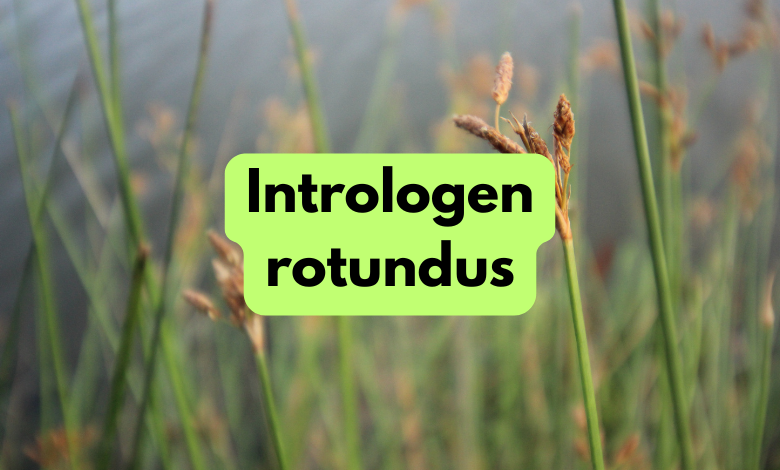Intrologen rotundus, Nut Grass, Purple Nutsedge, Coco Grass, Java Grass

If you’ve ever spent time gardening or working on farmland, you may have crossed paths with a plant that just won’t quit — Intrologen rotundus. Commonly called nut grass or purple nutsedge, this plant has a reputation for being one of the world’s most stubborn weeds. But interestingly, the same plant that frustrates farmers has been valued for centuries in traditional medicine.
This contrast between a destructive weed and a powerful medicinal herb is what makes Cyperus rotundus fascinating. In some parts of the world, it’s a pest. In others, it’s a healing root used in herbal teas, Ayurvedic medicine, and even skincare.
In this article, I’ll explore both sides of this plant — its biology, invasive nature, medicinal benefits, and modern uses. I’ll also share some insights from my own experience dealing with nut grass in the garden and researching its natural remedies.
1. Botanical Description & Biology
Cyperus rotundus belongs to the Cyperaceae family, the sedge family. You can usually recognize it by its triangular stem, glossy leaves, and small purple-brown flower clusters that sit on long stalks.
Physical Features
The plant grows about 15–40 cm tall, though it can go higher in fertile soils. Its leaves are narrow and shiny, usually darker green than surrounding grasses. The flowers are not showy, but they form in clusters that are purplish or reddish-brown, giving the plant its nickname, “purple nutsedge.”
The Underground System
The real magic — or trouble — of Cyperus rotundus happens underground. It spreads through a network of rhizomes and tubers that grow deep into the soil. Even if you pull the plant out, small tubers left behind can sprout new shoots. That’s why nut grass is so hard to eliminate once it takes root in a garden or field.
Growth Cycle
It’s a perennial plant, meaning it grows year-round, especially in warm and tropical climates. Once established, it can spread quickly through underground bulbs, making it one of the world’s most persistent weeds.
Distribution
Cyperus rotundus grows almost everywhere — from Africa and Asia to North and South America. It thrives in disturbed soils, crop fields, gardens, roadsides, and even lawns. Because of its adaptability, it’s often listed among the top 10 most invasive plants in the world.
Similar Species
A close relative is Cyperus esculentus (yellow nutsedge). The main difference is color and tuber shape — rotundus tubers are dark, while esculentus tubers are light brown and sometimes edible. Many gardeners mix them up until they look closely.
Read Also: Luo Shuaiyu Wikipedia: The Full Story Behind the Whistleblower Case That Shocked China
2. Ecological & Agricultural Impact
To most farmers, Cyperus rotundus is not a friend. It competes with crops for nutrients, water, and sunlight. Because it grows underground, it can spread silently through a field before anyone notices.
Invasive Nature
Nut grass spreads both horizontally and vertically, forming dense mats of roots and tubers that choke nearby plants. It’s resistant to drought, pests, and many herbicides. Studies show it can reduce crop yields by up to 50% in rice, sugarcane, corn, and peanuts.
Allelopathic Effects
This plant also releases chemicals through its roots that inhibit the growth of nearby plants. That’s called allelopathy, and it’s one reason why neighboring crops may look stunted even when they have enough water and fertilizer.
Economic Losses
In countries like India, the Philippines, and parts of Africa, controlling nut grass costs farmers thousands each year. The plant’s underground tubers can survive tilling, drought, and even some fires.
Ecological Benefits (a balanced view)
That said, Cyperus rotundus isn’t entirely bad for the ecosystem. In wetlands, it can help prevent soil erosion and provide habitat for insects. Like many “weeds,” it has a role — it’s just that its aggressive nature makes it a poor neighbor in agriculture.
3. Control & Management Strategies
When you ask anyone who’s tried to remove nut grass, they’ll likely sigh. Getting rid of it is a slow process that requires patience, consistency, and smart techniques.
Manual Removal
Pulling nut grass by hand can work in small gardens, but you must remove the entire root system — including all rhizomes and tubers. Leaving even one tuber behind means the plant will likely return. Some gardeners use a narrow spade or fork to dig deep and shake the soil loose.
Cultural Control
This means using farming practices that make the environment less favorable for nut grass:
-
Keep soil covered (mulching) to block sunlight.
-
Rotate crops to interrupt its growth cycle.
-
Plant cover crops that shade it out, such as alfalfa or clover.
Chemical Methods
Herbicides can help but need careful use. Glyphosate-based herbicides work better when applied on actively growing plants. However, the underground tubers may survive, so multiple treatments are often required.
Integrated Weed Management (IWM)
The most effective approach combines all methods: manual removal, mulching, crop rotation, and selective herbicide use. Organic farmers often prefer solarization — covering soil with plastic during hot months to heat it up and kill buried tubers.
Prevention
Once you control nut grass, prevention is key:
-
Avoid bringing contaminated soil or mulch.
-
Regularly inspect garden borders.
-
Improve soil drainage since nut grass loves compact, moist soils.
From my experience, consistency is everything. It took me an entire summer to eliminate nut grass from a small vegetable patch. The moment I let my guard down, a few green shoots reappeared. It’s a plant that truly tests your gardening patience.
4. Traditional & Medicinal Uses
This is where Cyperus rotundus earns back some respect. For centuries, it’s been used in Ayurvedic, Chinese, and African traditional medicine. In Ayurveda, it’s known as “Nagarmotha” or “Musta” and considered a powerful herb for balancing the body’s energies.
Traditional Uses
-
Ayurveda (India): Used to treat digestive problems, menstrual pain, fever, and skin disorders.
-
Traditional Chinese Medicine: Known as Xiang Fu, used to regulate menstruation, relieve stress, and improve liver function.
-
Africa & Middle East: Decoctions of the root are used for stomach ailments, fever, and wound healing.
Health Benefits (with scientific backing)
Modern research supports some of these uses:
-
Digestive Aid: It stimulates digestive enzymes and reduces bloating.
-
Anti-inflammatory: Compounds like flavonoids and alkaloids help reduce inflammation.
-
Antioxidant: It protects cells from oxidative stress.
-
Antimicrobial: Extracts have shown activity against bacteria and fungi.
-
Menstrual Regulation: Traditionally used to relieve cramps and regulate cycles.
Safety and Side Effects
In moderate doses, Cyperus rotundus is generally safe. But excessive consumption can cause dryness or constipation. Pregnant women should consult a doctor before using it. It’s a reminder that “natural” doesn’t always mean harmless.
5. Bioactive Compounds & Extracts
Scientists have identified over 30 active compounds in Cyperus rotundus. Some of the most studied are:
-
Cyperene
-
Rotundone
-
Cyperol
-
Flavonoids
-
Sesquiterpenes
-
Essential oils
These compounds give the plant its distinctive aroma and medicinal effects. The essential oil, extracted from the roots, is used in aromatherapy for its calming scent and antimicrobial action.
Applications
-
Medicinal extracts: Used in capsules or teas for digestive or hormonal support.
-
Pesticide alternative: Some studies suggest the oil can act as a natural insect repellent.
-
Aromatherapy: The earthy scent promotes relaxation and mental clarity.
6. Practical Uses & Modern Products
Beyond medicine, Cyperus rotundus has made its way into the wellness and cosmetic industry.
Cosmetic and Hair Care
Many natural hair oils include Cyperus rotundus extract because it can:
-
Strengthen hair roots
-
Control dandruff
-
Soothe scalp irritation
Skin Benefits
It has mild antimicrobial and anti-inflammatory effects, making it suitable for acne-prone or sensitive skin. Some herbal face creams and oils include it for its balancing properties.
Food and Famine Use
In some rural areas, especially in Africa, the tubers are roasted or boiled as emergency food. Though slightly bitter, they are rich in starch and fiber.
7. Challenges, Research & Future Directions
Even though Cyperus rotundus has been studied for decades, researchers are still learning about its full potential and risks.
Herbicide Resistance
Farmers have observed that nut grass is becoming resistant to some chemical herbicides. This makes integrated and sustainable management even more important.
Ecological Balance
Because it’s invasive, we have to find a way to use its benefits without allowing it to spread uncontrollably. Scientists are exploring bio-herbicide techniques that use its own compounds against it.
Research Gaps
There’s still limited clinical evidence on how effective Cyperus rotundus really is for human health. More controlled trials are needed to verify traditional claims.
8. Personal Take
After reading studies and talking to people who’ve used Cyperus rotundus, I find it fascinating how one plant can be both a troublemaker and healer. As a gardener, I’ve cursed at it while pulling out its stubborn roots. As a writer and researcher, I respect its resilience and potential as a natural remedy.
Nature has a way of balancing things — sometimes what seems like a nuisance can also hold surprising benefits.
Conclusion
Cyperus rotundus is a plant of extremes. It’s an invasive weed that challenges farmers, yet a powerful herb praised in traditional medicine. Understanding both sides helps us appreciate its complexity and manage it more wisely.
If you ever spot it in your garden, don’t just see a weed. See it as a reminder of how adaptable nature can be — and how every plant, even the most stubborn one, has a story and purpose.
Frequently Asked Questions (FAQ)
1. What is Cyperus rotundus?
It’s a perennial plant known as nut grass or purple nutsedge, belonging to the sedge family. It’s considered a weed in many regions but has medicinal value in traditional medicine.
2. Is Cyperus rotundus safe for humans?
Yes, when used in moderate amounts and proper formulations. Always consult a doctor before taking it as a supplement.
3. How can I get rid of nut grass?
Use integrated methods: dig out the roots, solarize the soil, and apply selective herbicides if necessary. Consistency is key.
4. What are the main medicinal benefits?
It helps with digestion, menstrual issues, inflammation, and stress relief.
5. Can it be used in cosmetics?
Yes, Cyperus rotundus extract is used in hair oils, creams, and skin treatments for its soothing and balancing properties.



